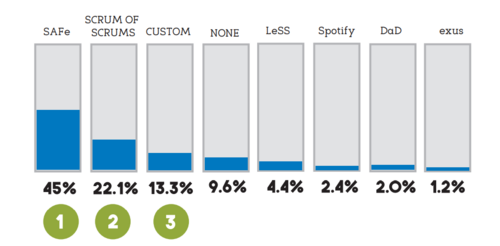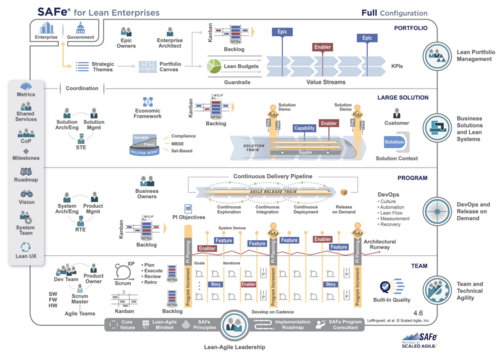(Re)Introducing Project Management in a SAFe world
Traditionally Software development has utilized Project, Program and Portfolio Management to support delivery. But With the introduction of the Scaled Agile Framework (SAFe) into development organizations from its release in 2011, the most popular Enterprise scale Agile model in the world [1] effectively advocated removing Project Managers from development organizations. The early SAFe versions advocacy of a new organization with new roles took traditional project, program and portfolio manager responsibilities and moved them (partially) into the new SAFe's roles such as Product Owners, Scrum Masters and RTE’s and Business Owners. This led many organizations to "throw out the baby with the bathwater" by ignoring the value of the project, program and portfolio management roles & their practices where they were not incorporated or clearly articulated in these early versions of SAFe. During the period 2011-2017 Project management as a separate formal practice within many software development Organizations literally had no place in those organizations that deployed SAFe as written. This is important because as of 2017 the SAFe methodology was used by 45% [1] of those firms using an Agile methodology at scale. Many of these firms have had to contend with a number of issues that this caused up until the acceptance of Project Management through its "(Re)introduction" in the form of an Agile Project Management Office (APMO) in the 2017 release of SAFe version 4,5. This new version implicitly accepted the role PMO's (and by extension Project Managers) play in strategy formation, Project and Program execution as well as owning and disseminating best practices (in this case represented in the SAFe model by the "Lean Centre of Excellence"). In this article we look at the issues that have arisen in many firms during their SAFe implementations and how implementing an APMO solves these issues. The article is intended for practitioners who are working in or with organizations that have deployed early versions of SAFe as part of the support for establishing an APMO along the lines now advocated by SAFe. It is also relevant or those organizations that are implementing SAFe but have not had an effective PMO in place before Note: Due to the relatively new and evolving nature of SAFe there is limited empirical data around specific “Implementation issues in Large Scale Agile transformations” [2] . As a consequence this article is more reliant more on Anecdotes, Personal Experience and other literature in this space.
Contents |
Scaled Agile Framework (SAFe)
According to the extensive "Scaling Agile Report 2017" by C-Prime .[1] SAFe is the most popular Scaling Agile methodology by far. It is more than twice as popular as its nearest competitor Scrum of Scrums (or Scrum @ Scale) and more than 3 times as the 3rd most popular choice "Custom" (representing an in house patchwork of approaches)
What is SAFe?
According to ScaledAgileFramework.com[3]:
Quoting Dean Leffingwell (the creator and chief methodologist of SAFe) [3]
“SAFe® for Lean Enterprises is a knowledge base of proven, integrated principles, practices, and competencies for achieving business agility using Lean, Agile, and DevOps.” “It “…is built around the Seven Core Competencies of the Lean Enterprise that are critical to achieving and sustaining a competitive advantage in an increasingly digital age”
ScaledAgileFramework.com illustrates the overall framework below. It makes this framework and support material available to all along with an extensive library of resources that can be used for free to support implementing and running SAFe in practice
The seven core competencies:
From the Sacledagileframework.com[3]
"Lean-Agile Leadership – Advancing and applying Lean-Agile leadership skills that drive and sustain organizational change by empowering individuals and teams to reach their highest potential
Team and Technical Agility – Driving team Agile behaviors as well as sound technical practices including Built-in Quality, Behavior-Driven Development (BDD), Agile testing, Test-Driven Development (TDD), and more
Agile Product Delivery – Building high-performing teams-of-teams that use design thinking and customer-centricity to provide a continuous flow of valuable products using DevOps, the
Continuous Delivery Pipeline, and Release on Demand Enterprise Solution Delivery – Building and sustaining the world’s largest software applications, networks, and cyber-physical solutions
Lean Portfolio Management – Executing portfolio vision and strategy formulation, chartering portfolios, creating the Vision, Lean budgets and Guardrails, as well as portfolio prioritization, and road mapping
Organizational Agility – Aligning strategy and execution by applying Lean and systems thinking approaches to strategy and investment funding, Agile portfolio operations, and governance
Continuous Learning Culture – Continually increasing knowledge, competence, and performance by becoming a learning organization committed to relentless improvement and innovation"
Levels & Objectives
SAFe's model aims to create an optimized "continuous delivery pipeline" via one or many Agile Release Trains (ARTs). There are 4 levels of SAFe suggested - "Essential", "Large Solution", "Portfolio" and a "Full" SAFe. All of ARTs should deliver improvements in delivery efficiency but at the Portfolio and Full levels the suggested organization changes to focus organization around the delivery of value with a more strategic portfolio emphasis relevant to larger companies that may have significant numbers of people working in a wide range of different business areas or providing a wide range of services
Introduction of Project, Program and Portfolio management
From SAFe 4,5 onwards we start to see the introduction of formal portfolio management processes as historically defined . First with Lean Budgets and then more features in each version until SAFe V5.0 which effectively introduces full portfolio management and portfolio optimization capabilities in the traditional project management sense with Portfolio Kanbans and Backlogs, Lean Budgets and project & program budget "Guardrails". By also introducing an APMO working with the Lean Center of Excellence it seems the model has created P3O's definition of program or portfolio offices
Roles and responsibilities
Developer and tester roles remain very similarly defined to the past but have new practices such as daily stand-ups, regular demo's & retrospectives but the roles responsibilities remain broadly the same but SAFe defines new roles in its organizations such as Scrum Master, Product Owner, Product Manager, Release Train Engineer and Solution Train Engineer, System Engineer & Solution Architects. This means may of the higher level expert and managerial positions change change substantially - having different relationships, responsibilities and reporting lines than.
What are the benefits of SAFE?
As advertised on ScaleAgileFramewrok.com:
20 – 50% increase in productivity
25 – 75% improvements in quality
30 – 75% faster time-to-market
10 – 50% increase in employee engagement and job satisfaction
Results like these sound very impressive. While Quality improvements and Employee engagement and satisfaction can be pretty straightforward to report and compare, productivity and time to market are much harder to compare directly before and after an agile transformation. Increases in productivity are often very difficult to quantify when the basis changes (I.e from hours to stories) how do you compare these apples and oranges? Likewise with Time to market - if estimation comparisons are flawed so is time to market
That said - and working back from quality metrics with some basic assumption (like the bugs that didn't need fixing after release are now available for new development) it seems clear that organizations gain significant efficiency improvements through SAFe
My personal experience at a Mid Sized software firm in 2016/7 where introducing cross functional team scrum to a traditionally Waterfall team raised delivery from 70-80% of estimated scope per delivery period to 104% within 12 months of introducing the working practices. In this case I mention we had the rare situation of 3 Agile teams having the old waterfall estimation process running before and after the teams went Agile as part of the main organizations processes so the figures are not subject to comparison errors. This experience would seem to support the kind of figures SAFe advertise.
Issues raised with SAFe
Project Management as a practice is challenged
For a number of different reasons Project Management as a practice is challenged during an Agile transformation
Culture Change within the development organization – In ADKAR (Prosci’s ADKAR model for best practice for Change Management) [4]. The A stands for Awareness of the need for change, absorbing this best practice the SAFe implementation model suggests creating “A buring platform”" [5]. as part of motivating people towards the change. This “Burning platform” creates a momentum away from old waterfall practices and the roles and responsibilities of the past and seeks to motivate people towards the new Organizational model. Where the SAFe model excludes project management it is only natural that those practicing SAFe will also do so
Culture of the wider Agile Community - The Agile community coming out of Scrum and finding itself newly empowered with extra roles and responsibilities and its practices being recognized and scaled up into management layers is permeated with a sentiment that old school project management is not relevant any more. For example: "When it comes to agile project management roles, most agile processes - Scrum in particular - do not include a project manager. Agile “project manager” roles and responsibilities are shared among others on the project, namely the team, Scrum Master and product owner" [6]. Although these are natural responses in this context the agile communities history and background in devleopment shows here by ignoring or discounting all of the other befits of project management. By dismissing project management as a practice the culture also discredits their more senior colleagues in Program and Portfolio management even though that is the area in the SAFe model furthest away from SAF’e scrum roots and the most immature parts of the model. Dean Leffingwell the creator of SAFe while introducing the APMO even tries to differentiate it from traditional PMO’s implying that old PMO’s were in some way not of equal value
Change in responsibilities in the organization - The responsibilities from most development organizations business as usual roles such as Team and department managers, tech leads and team leads can easily become Srum Masters, RTE’s or Architects. The majority of roles in a company fall into these categories but project management does not.
Consultants become the change agents for SAFe – Traditionally most companies would look to their own PMO to source Program Management resources for initiatives of this size and would still retain ownership and accountability even where consultants or third parties were bought in to manage the execution. But while implementing SAFe most companies seek external SAFe consultancy support to act as early “Lean Agile Change Agents “Cite error: Closing </ref> missing for <ref> tag
As Dean Leffingwell himself says in his 2010 book "Agile Software Requirements"[7] "Project Managers should be re-tasked as Agile Project Managers." This thought published before the release of SAFe appears to have taken some time to emerge in the SAFe framework
Suggestions for further reading
Scaledagileframework https://www.scaledagileframework.com/
The Agile Manifesto: https://agilemanifesto.org/
Agile Alliance: https://www.agilealliance.org/resources
Disciplined Agile https://www.pmi.org/disciplined-agile/start-here
HotPMO: https://www.hotpmo.com/
© SAFe and Scaled Agile Framework are registered trademarks of Scaled Agile, Inc
- ↑ 1.0 1.1 1.2 C-Prime, https://www.cprime.com/wp-content/uploads/woocommerce_uploads/2017/09/cPrime-Scaling-Agile-Survey-17-Digital.pdf, (NC-Prime, 2017), p14.
- ↑ '[Dikert et al. 2016; Alsaqaf et al. 2019;Uludag et al ˘ . 2018].
- ↑ 3.0 3.1 3.2 https://www.scaledagileframework.com/about/
- ↑ https://www.prosci.com/adkar/adkar-model/
- ↑ https://www.scaledagileframework.com/implementation-roadmap/
- ↑ https://www.mountaingoatsoftware.com/agile/agile-project-management
- ↑ Dean Leffingwell, Agile Software Requirements, (Wesley, 2010),

